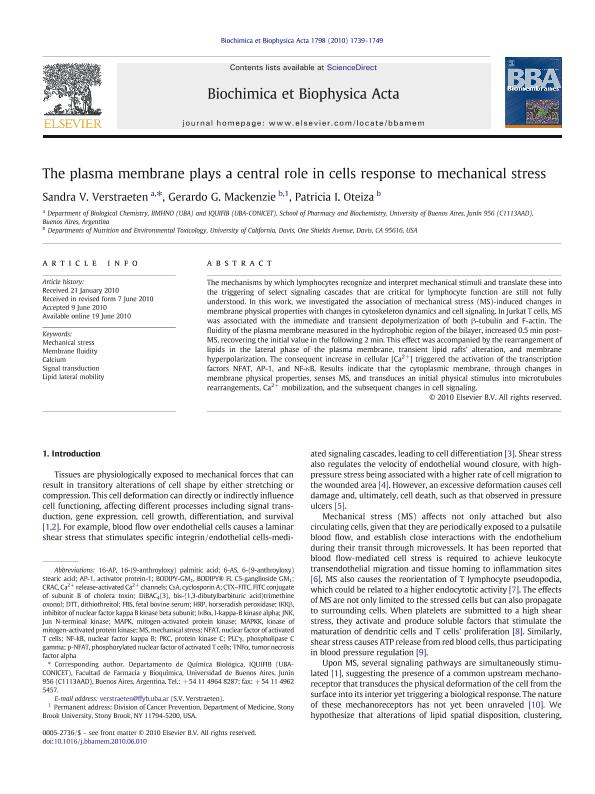Artículo
The plasma membrane plays a central role in cells response to mechanical stress
Fecha de publicación:
09/2010
Editorial:
Elsevier Science
Revista:
Biochimica et Biophysica Acta - Biomembranes
ISSN:
0005-2736
Idioma:
Inglés
Tipo de recurso:
Artículo publicado
Clasificación temática:
Resumen
The mechanisms by which lymphocytes recognize and interpret mechanical stimuli and translate these into the triggering of select signaling cascades that are critical for lymphocyte function are still not fully understood. In this work, we investigated the association of mechanical stress (MS)-induced changes in membrane physical properties with changes in cytoskeleton dynamics and cell signaling. In Jurkat T cells, MS was associated with the immediate and transient depolymerization of both β-tubulin and F-actin. The fluidity of the plasma membrane measured in the hydrophobic region of the bilayer, increased 0.5 min post-MS, recovering the initial value in the following 2 min. This effect was accompanied by the rearrangement of lipids in the lateral phase of the plasma membrane, transient lipid rafts' alteration, and membrane hyperpolarization. The consequent increase in cellular [Ca2+] triggered the activation of the transcription factors NFAT, AP-1, and NF-κB. Results indicate that the cytoplasmic membrane, through changes in membrane physical properties, senses MS, and transduces an initial physical stimulus into microtubules rearrangements, Ca2+ mobilization, and the subsequent changes in cell signaling.
Archivos asociados
Licencia
Identificadores
Colecciones
Articulos(IQUIFIB)
Articulos de INST.DE QUIMICA Y FISICO-QUIMICA BIOLOGICAS "PROF. ALEJANDRO C. PALADINI"
Articulos de INST.DE QUIMICA Y FISICO-QUIMICA BIOLOGICAS "PROF. ALEJANDRO C. PALADINI"
Citación
Verstraeten, Sandra Viviana; Mackenzie, Gerardo G.; Oteiza, Patricia Isabel; The plasma membrane plays a central role in cells response to mechanical stress; Elsevier Science; Biochimica et Biophysica Acta - Biomembranes; 1798; 9; 9-2010; 1739-1749
Compartir
Altmétricas




